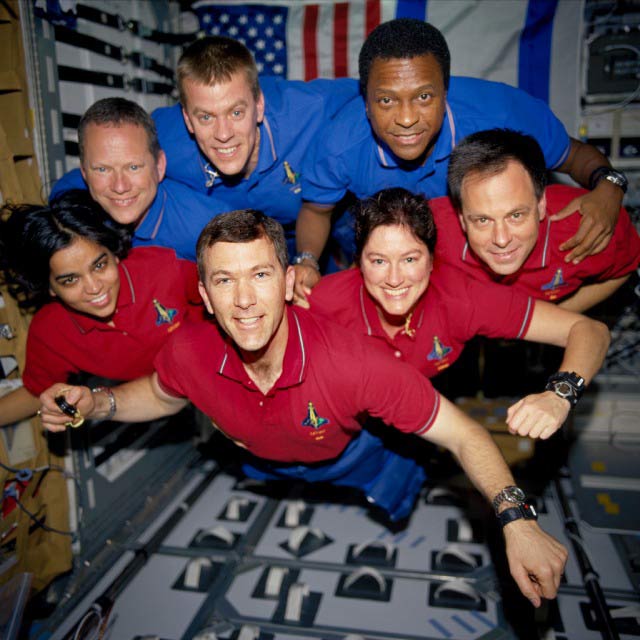New Columbia Accident Report to Help Astronaut Safety

A new NASAreport on the final moments of the seven astronauts killed during the 2003 Columbiaspace shuttle tragedy is a vital safety tool for future spaceflyers andspacecraft despite hitting close to home for the U.S. agency.
The 400-pagereport released Tuesday givesa detailed account of how Columbia?s crew attempted to recover control ofthe doomed shuttle on Feb. 1, 2003 as it broke apart high above Texas.
?This work,we all hope, will go toward making spaceflight safer for all those who venture intospace in the future,? said Wayne Hale, a former shuttle program manager who isnow NASA?s deputy associate administrator for strategic partnerships, in ateleconference with reporters. ?This report confirms that although the valiantColumbia crew tried every possible way to maintain control of theirvehicle, the accident was not ultimately survivable.?
Columbia?screw was killed in seconds and had only a brief 40-second period between theshuttle?s loss of control and its lethal depressurization in which to act, thereport stated.
A hard,long look
A team ofNASA astronauts, engineers and pilots spent more than four years reconstructingthe Columbia crew?s descent in the report, which is entitled the ?Columbia CrewSurvival Investigation Report.? Based on the study, the team found fivedistinct lethal events during Columbia?s descent and made 30 recommendations toenhance astronaut safety and survivability in the event of a future catastrophicfailure.
But the reportalso allowed some team members to work through the grief of theirlost comrades.
Breaking space news, the latest updates on rocket launches, skywatching events and more!
?I wouldsay this is one of the hardest things I?ve ever done technically andemotionally,? said NASA shuttle commander Pamela Melroy, deputy project managerof the study team. ?But it was so important and I felt sure that we neededto make the best of all the knowledge we could get out of the action.?
NASAofficials said the space agency released the report today, between theChristmas and New Year?s holidays, to give family members of the lostColumbia crew time to discuss it with their children before the school year resumesnext month. Portions of the report were also redacted to respect the privacy ofColumbia?s crew and families.
Columbiabroke apart on Feb. 1, 2003 while re-entering the Earth?s atmosphere at the endof a 16-day science mission in orbit. The spacecraft?s vital heat shield wasdamaged during its Jan. 16 launch, allowing superheated atmospheric gases to entera hole in the vehicle?s left wing edge and lead to its destruction.
Returningto Earth aboard Columbia that day were shuttle commanderRick Husband, pilot Willie McCool, mission specialists KalpanaChawla, Laurel Clark, Michael Anderson, David Brownand Ilan Ramon, Israel?s first astronaut. Exposure tohigh altitude and blunt trauma caused their deaths, the report confirmed.
Lessonslearned
Of therecommendations stemming from the report, Hale said that one of the most immediatesafety changes incorporated into current space shuttles are inertial wheel lockmodifications on crew seats.
Themechanism is designed to lock an astronauts seat restraints due to externalforces much like the seatbelt of a car locks during a sudden stop or impact,Hale said. But during the Columbia accident, the restraints did not lock asdesigned, subjecting the astronauts strapped in place to extreme forces andtrauma.
Seatmodifications will also be employed on NASA?s new spacecraft, theOrion crew capsule, to more fully integrate them into the cabin. While theywould not have saved Columbia?s crew, they could save lives under a less severeemergency, Hale said.
Launch and landingpressure suits for Orion crews will also be designed to be sealed duringre-entry, said Jeff Hanley, manager of NASA?s Constellation program overseeingOrion?s development. The current bright orange partial pressure suits seep pureoxygen into a shuttle cabin when the visors are sealed, violating NASA?sflammability rules.
DuringColumbia?s descent, one crew member was not fully strapped into place. Anotherdid not have a helmet secured, while the six that did had their visors opened,NASA?s report concluded. Three of the crew members did not have their suitgloves locked in place. ?
Whilehaving the pressure suits fully donned would not have saved Columbia?s crew, Melroysaid their status did merit changes in shuttle crew training protocols.
In additionto modifying astronaut training to enhance a crew?s ability to shift fromspacecraft recovery to survival, NASA has also updated prelanding milestones toallow spaceflyers to focus on their own preparations in addition to getting anorbiter ready for re-entry.
?Theemphasis on deorbit prep has always been on preparing the vehicle,? saidMelroy, a three-time shuttle flyer. ?There?s an increased recognition of theequal importance of configuring the crew equipment for entry.?
The newColumbia accident report is expected to be NASA?s last investigation into the lost shuttleflight, NASA officials said. While the report represents a chance for closurefor some at NASA, others hope it will shore up the foundation to avoid futureaccidents.
?Spaceflighttakes eternal vigilance,? said Hale. ?Our goal here is to do our best toprevent accidents in the future and that is not a subject that is ever going tobe closed.?
- Video - In Their Own Words...Remembering Columbia's Crew
- Images - Photos From Columbia's Last Flight
- Special Report: Space Shuttle Columbia Tragedy

Tariq is the award-winning Editor-in-Chief of Space.com and joined the team in 2001. He covers human spaceflight, as well as skywatching and entertainment. He became Space.com's Editor-in-Chief in 2019. Before joining Space.com, Tariq was a staff reporter for The Los Angeles Times covering education and city beats in La Habra, Fullerton and Huntington Beach. He's a recipient of the 2022 Harry Kolcum Award for excellence in space reporting and the 2025 Space Pioneer Award from the National Space Society. He is an Eagle Scout and Space Camp alum with journalism degrees from the USC and NYU. You can find Tariq at Space.com and as the co-host to the This Week In Space podcast on the TWiT network. To see his latest project, you can follow Tariq on Twitter @tariqjmalik.
